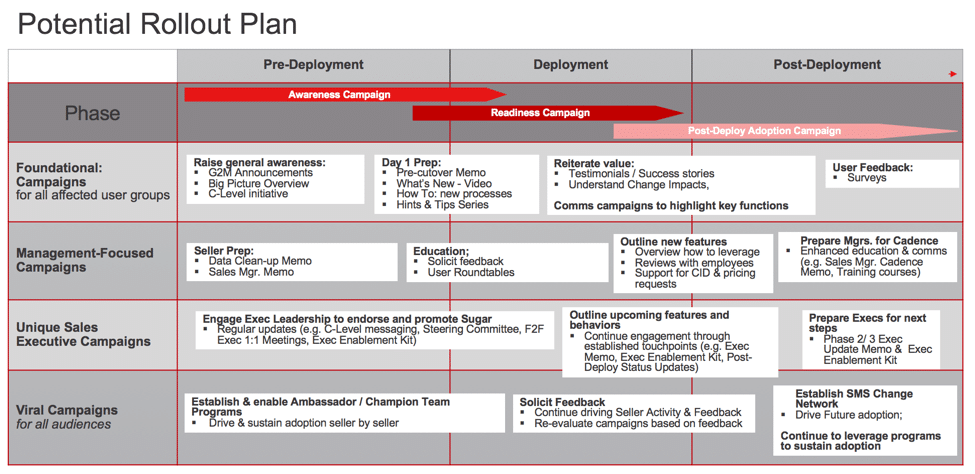CRM Adoption: Five Tips for Staying On Course Post Deployment
Whether you are one month, one year, or several years into a CRM deployment, it is always important to perform “health checks” to insure the project is going smoothly. Just because the software is in place, does not always mean it is being used at optimal levels or driving the best return. These five tips can help your business keep the CRM initiative on track and continue bringing positive returns…
Tip 1: Remember, CRM is a Journey
When it comes to CRM, it is always important to remember to look at your initiative as a journey, not a destination.
 We usually like to think of IT and business projects as having a set lifecycle – we select tools, implement them – and move on. Set it and forget it. But a CRM initiative is different. It truly is a journey – and it requires constant monitoring and maintenance from both a people and technology perspective to continue to drive value.
We usually like to think of IT and business projects as having a set lifecycle – we select tools, implement them – and move on. Set it and forget it. But a CRM initiative is different. It truly is a journey – and it requires constant monitoring and maintenance from both a people and technology perspective to continue to drive value.
And really, a CRM initiative isn’t a system, or piece of software – it is an encompassing program. A program where people, process and technology intersect – requiring orchestration and care.
So, even after “go live,” it is critical to constantly assess and reevaluate the processes, configurations, and policies governing your CRM deployment.
Tip 2: Set Your Project Up for Success
Even if you are far along a CRM deployment, or have already gone live, it is never too late to set up a strong governance policy to insure the system is working at optimal levels. The below guidelines can be implemented any time, and create a “benevolent cycle” of best practices around monitoring and fostering early and late-stage adoption of the CRM.
- Communications
- Awareness:
- “E-mercials” – Digital correspondence to all stakeholders to promote the project or latest phase of the project early and often
- Overview presentation from Exec Sponsor (recorded & scripted)
- Materials to use in launch meetings (Training schedules, existing newsletters, product overviews)
- Actions
- Emails driving from awareness to actions needed to prepare (pre-launch)
- Updates, blog alerts, Quick Reference Cards, New user communications done through branded banners, email links, etc.
- Creation of an Online Repository that provides a “one-stop shop” for all information (awareness, action, education, materials, etc.)
- Training
- Philosophy
- Blended approach – including awareness videos, web-based training
- Cultural decision on re-training – Mandatory vs “Strong Encouragement”
- Primary Deliverable
- On-demand, self-learning, 1 hour modules focused on prime features or modules in current or next project
- Post deployment – additional / advanced topics
- Coaching, Internal Community Posts, etc.
- Metrics
- Track training attendance
- Collect overall usage metrics for new features, etc.
- Philosophy
- Awareness:
Tip 3: Focus on the Metrics that Matter
As the old adage goes – you can’t manage what you don’t measure. Too often, organizations understand the need for adoption, but may not identify simple bellwethers of proper and optimal system usage.
Below are three types of usage metrics you can quickly collect, measure and analyze to generate an instant CRM health check for your deployment, anytime.
Tip 4: Develop Solid Post-Deployment Adoption Strategies
Below are some simple best practices for building a solid adoption campaign after deploying the CRM software. By leveraging these best practices, you can insure constant positive project development:
- Drive sustained adoption through regular touchpoints based on analysis of usage and adoption metrics
- Introduce and support new functionality including major communications campaigns that support key functions
- Gather feedback and address questions
- Celebrate benefits of working in new environment through participation in sharing of success stories
- Reinforce desired behavior through continued exec endorsement and user education
Tip 5: Create Adoption Plans at Every Phase
Every company’s deployment is different, which means your path to 100 percent adoption will be unique as well. However, by using these sample adoption plan templates you can craft a custom action plan for your business, for every stage of deployment.


A CRM system is only as good as the data inside of it. And without constant active use by your employees, the data and subsequent insights suffer from the law of diminishing returns. However, by taking a proactive stance towards driving adoption, your organization can continue to “sell” the benefits of the system to users, keep them educated on best practices, and more quickly onboard new employees to the system.
Adoption is not a singular event – it must be constantly monitored, and all employees in the system need to feel the system makes them better at their jobs, and not see the CRM as a time and productivity drain. Following the preceding steps and best practices can help set your organization on a path to adoption success, and continue to increase the value and overall return on your CRM investment.

